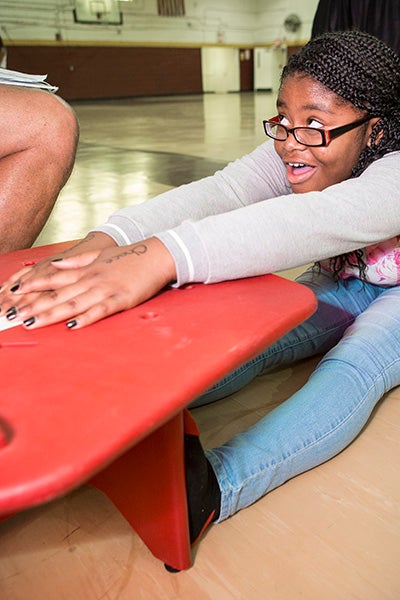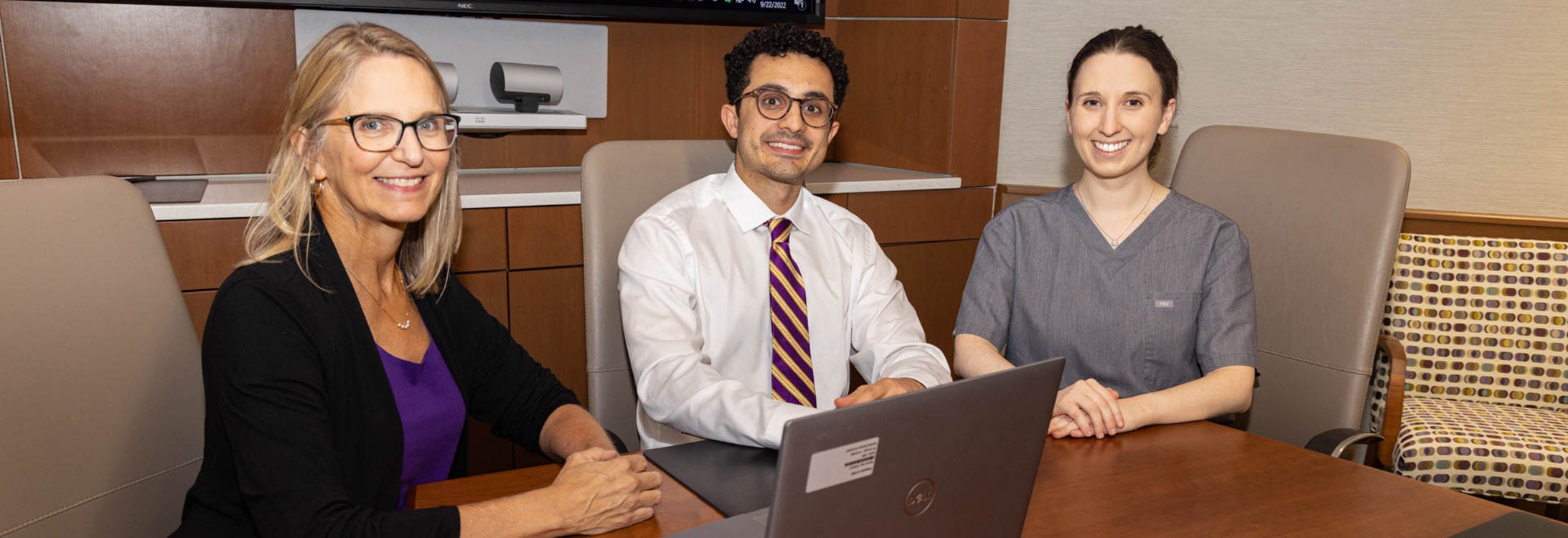LET’S GET PHYSICAL
ECU medical student research highlights rural adolescent physical activity, health disparities
A student in the Brody School of Medicine and a pediatric resident at ECU Health have published their research on physical activity in adolescents attending rural schools.
Their findings suggest that more physical education is needed in rural eastern North Carolina middle schools to meet the health needs of adolescents — and to address health disparities evident across those age groups.
Brody student Sina Kazemzadeh and co-author Dr. Chloe Opper published the paper, “Determining Trends and Factors Associated with Self-Reported Physical Activity among Adolescents” in the International Journal of Environmental Research and Public Health. It appears in the journal’s special issue, “Physical Activity, Body Composition, Health Behaviors and Related Health Issues.”

A student at Ahoskie Middle School stretches to meet her fitness goal during a MATCH Wellness session early on in the program. The program contributed to research published by an ECU medical student calling for more physical education in rural schools.
The publication is the culmination of work Kazemzadeh and Opper began in the summer of 2020; the study yielded three major findings.
“Most adolescents in our study reported that they did not get the recommended amount of physical activity set by the CDC, which is 60 minutes of physical activity a day,” Kazemzadeh said. “This is consistent with adolescents in the United States.”
Schools that offered consistent physical education yielded more active students.
“Participants who attended schools with more physical education reported getting more physical activity,” he said. “We brought this disparity to light and called for policy changes to increase the amount of physical education in eastern North Carolina middle schools.”
The study also revealed significant disparities among participants.
“Overweight, underweight, obese, female and minority race students reported less physical activity than their healthy weight, male and white peers,” Kazemzadeh said. “It has also been reported in literature that minority and female adolescents do not usually get as much physical activity as their peers, and that most adolescents in general are not getting the recommended amount of physical activity. So, our findings did not really surprise me, but it was interesting to see that these trends are true and significant in rural, eastern North Carolina as well.”
Kazemzadeh is a fourth-year medical student and Research Distinction Track Scholar in Brody, and Opper, a Brody graduate, also completed that distinction track, a rigorous program designed to increase exposure to research and ensure that medical students are equipped to discover the latest scientific evidence and use it in the practice of medicine. The program is one of four distinction tracks offered by Brody; others include Service Learning, Medical Education and Teaching and Health System Transformation and Leadership.
The current published research builds on Opper’s work during her time as a Research Track Distinction Scholar. Some of the data used in the study came from ECU’s Motivating Adolescents with Technology to Choose Health (MATCH) Wellness program, an interdisciplinary, community-university partnership created to combat the epidemic of childhood obesity.
“We found that most adolescents that participated in the MATCH intervention did not get the recommended amount of physical activity — 60 minutes of physical activity daily. Interestingly, we found that a higher percentage of students reporting more physical activity is correlated with schools providing more frequent PE time,” Opper said. “Although it has been documented in previous literature, minority racial populations reporting less physical activity than their peers, especially minority female populations, is concerning and highlights that there should be specifically targeted school-based physical education and physical activity opportunities.”

An Ahoskie Middle School student participates in a physical activity exercise through MATCH Wellness, a program created to combat childhood obesity and that was recently included in research on adolescent physical activity at the Brody School of Medicine.
Opper added that while it is well known that health disparities exist when discussing obesity and physical activity, especially in rural, more racially diverse areas, the data can help encourage healthy choices in adolescents.
“Now that we have data specifically in our rural North Carolina community highlighting these disparities, especially for minority female populations, we can hopefully highlight this issue and spark advocacy initiatives and policy changes that give these kids the tools to make those healthy decisions,” she said.
Kazemzadeh’s path at Brody has allowed him to develop his interest areas and passions for health care at the community level.
“I have lived in North Carolina almost my whole life, so it is nice to bring attention to some of the public health disparities in underserved parts of North Carolina,” he said. “I’ve always been passionate about public health and community outreach, especially for kids as adolescents are at a crucial time of their life where decisions they make can have a long-lasting impact.”
Dr. Suzanne Lazorick was a professor of pediatrics at Brody during this study and a key leader of the MATCH Wellness program. She is now professor and chair of Brody’s Department of Public Health. She said it was rewarding to watch the research culminate in publication, especially with the timing of the pandemic.
“That time of the shut-down was so challenging and there was fear that opportunities — like student projects and collaborative research — would be prevented or diminished,” she said. “To have had this work progress and succeed is an example of the resilience and determination of our students, and it demonstrates how commitment and perseverance of both students and faculty can lead to overcoming obstacles.”
Lazorick said the student research also lends to the knowledge base of health disparities across the east.
“Research about health disparities is tied to the mission of the school,” she said, “as we strive to address challenges of the region.”
Opper said the exposure to research while in Brody’s Research Distinction Track can help improve patient care in the future.
“Doing research like this not only helps develops the skills that we need to become physician researchers and investigate other important clinical questions for our patients,” she said, “but it also changes how you communicate and identify at-risk populations.”
